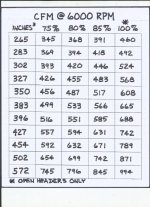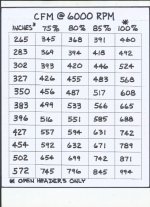toobroketoretire
Banned
My neighbor stopped by yesterday to show me his new ZZ6 350" crate engine that he just installed in his '71 Chevrolet 1/2 ton pickup. It looked terrific with it's serpentine belt system, aluminum valve covers, and aluminum fast burn cylinder heads. Then he showed me his new 770 cfm vacuum secondary Holley and that's when I let out a BIG sigh. I told him a 350" engine can only swallow 608 cfm at 6000 rpm with a 100% volumetric efficiency and told him a street engine can only manage an 80-85% efficiency because of the mandatory exhaust system. Figuring an 85% efficiency his engine could only swallow 517 cfm at 6000 rpm BUT as he has a TH350 that forces the full throttle upshifts at only 4500 rpm that limits the air intake to a dismal 388 cfm; about half of what his new 770 cfm Holley is rated for. I told him his secondaries would most likely NEVER open because a 770 cfm Holley is way too big for his set up. Fortunately he chose a vacuum secondary Holley because a mechanical secondary (aka double pumper) would have been a total disaster as they aren't suitable for street use.
People make this same dreadful mistake all the time as they choose carburetors that are way too big for their application. Summit Racing recommends 1-1/2 cfm per cubic inch for street engines which would equal 525 cfm for a 350" engine. As my neighbor's new ZZ6 engine will never be twisted to 6000 rpm a little 500 cfm Edelbrock or 465 cfm Holley would have been the ideal choices.
I have posted my carburetor sizing chart in the past but here it is again so you folks can see just how much your engines can actually swallow at different volumetric efficiencies. Notice how my sizing chart calls for 517 cfm at an 85% efficiency which is almost identical to Summit Racing's 525 cfm need.
People make this same dreadful mistake all the time as they choose carburetors that are way too big for their application. Summit Racing recommends 1-1/2 cfm per cubic inch for street engines which would equal 525 cfm for a 350" engine. As my neighbor's new ZZ6 engine will never be twisted to 6000 rpm a little 500 cfm Edelbrock or 465 cfm Holley would have been the ideal choices.
I have posted my carburetor sizing chart in the past but here it is again so you folks can see just how much your engines can actually swallow at different volumetric efficiencies. Notice how my sizing chart calls for 517 cfm at an 85% efficiency which is almost identical to Summit Racing's 525 cfm need.
Attachments
Last edited:







